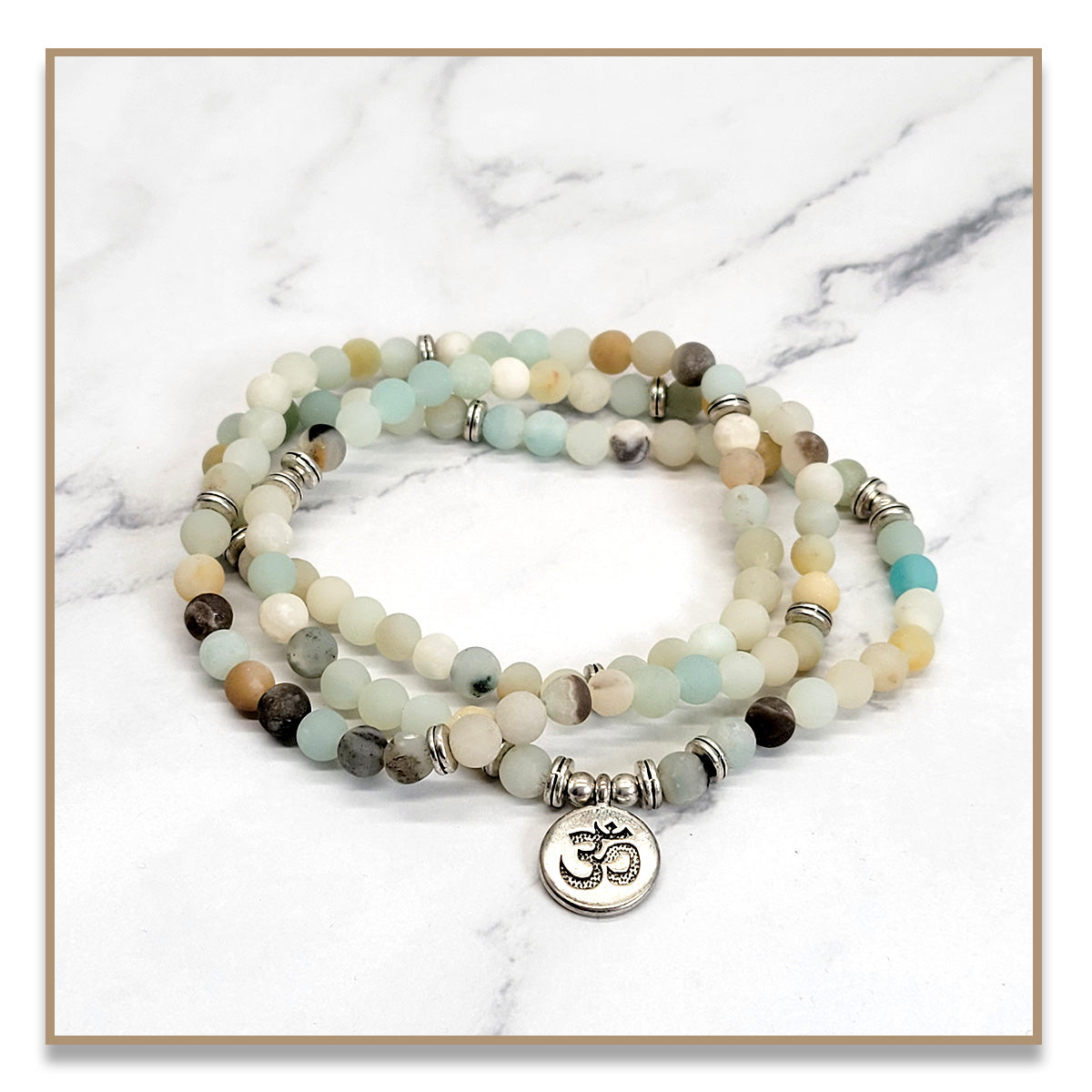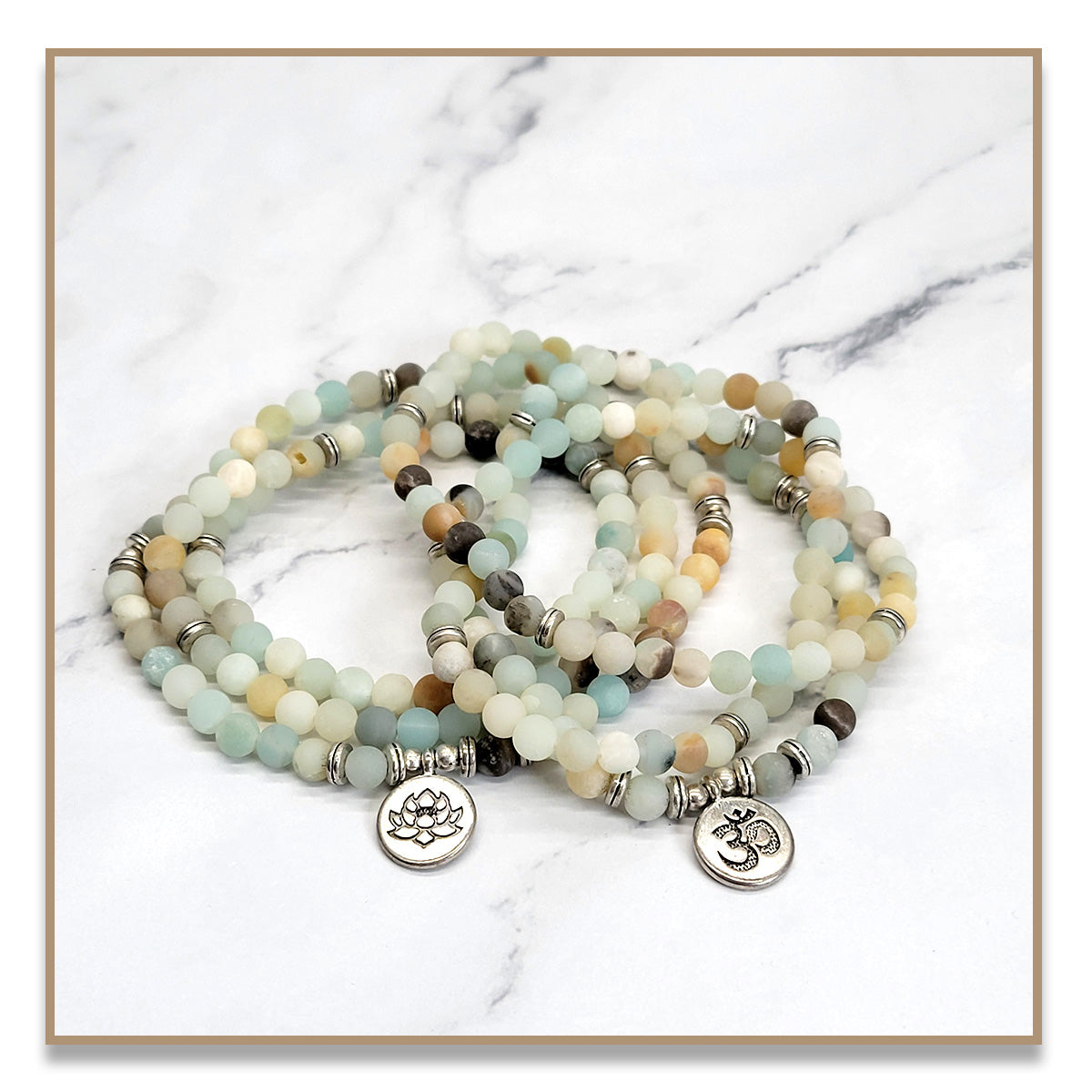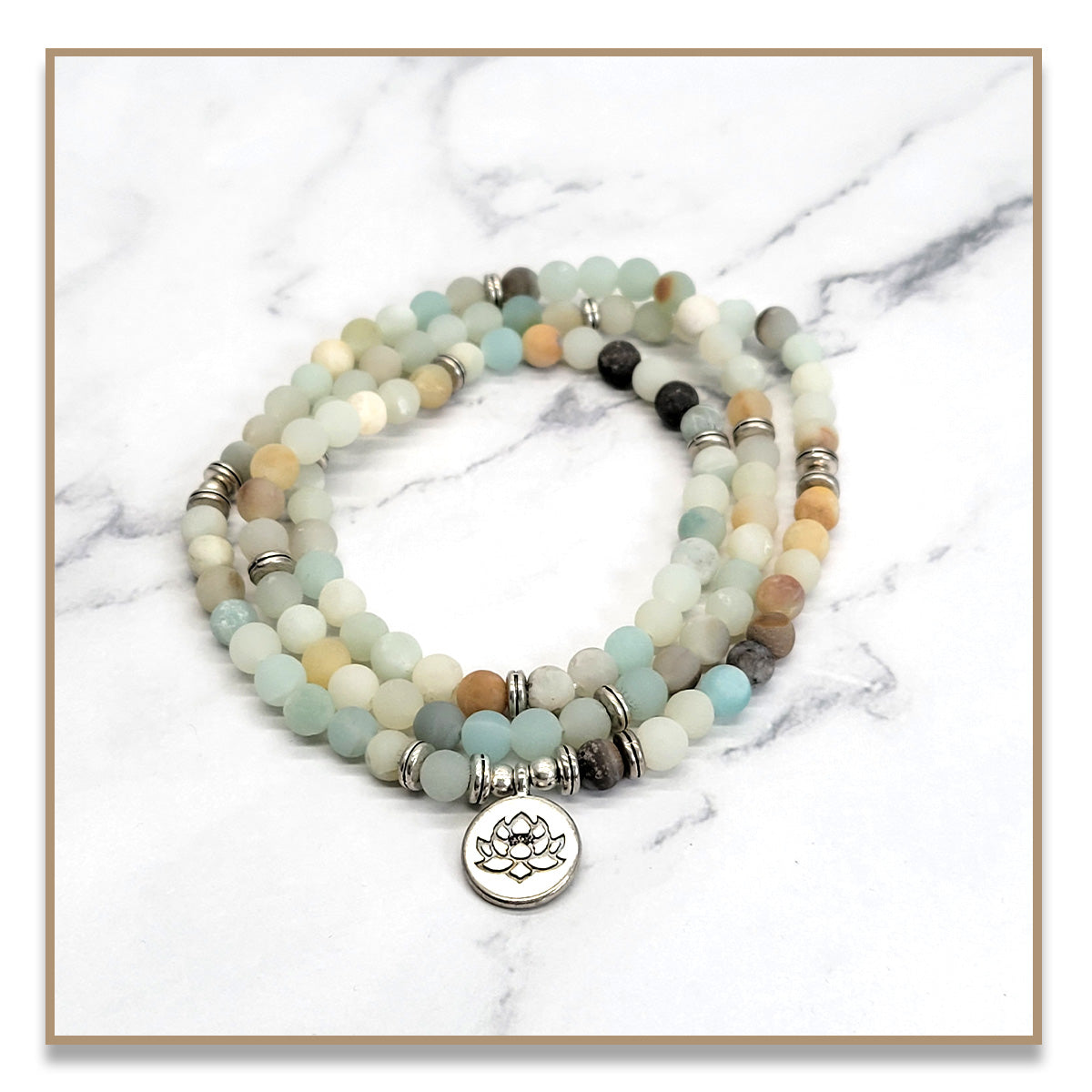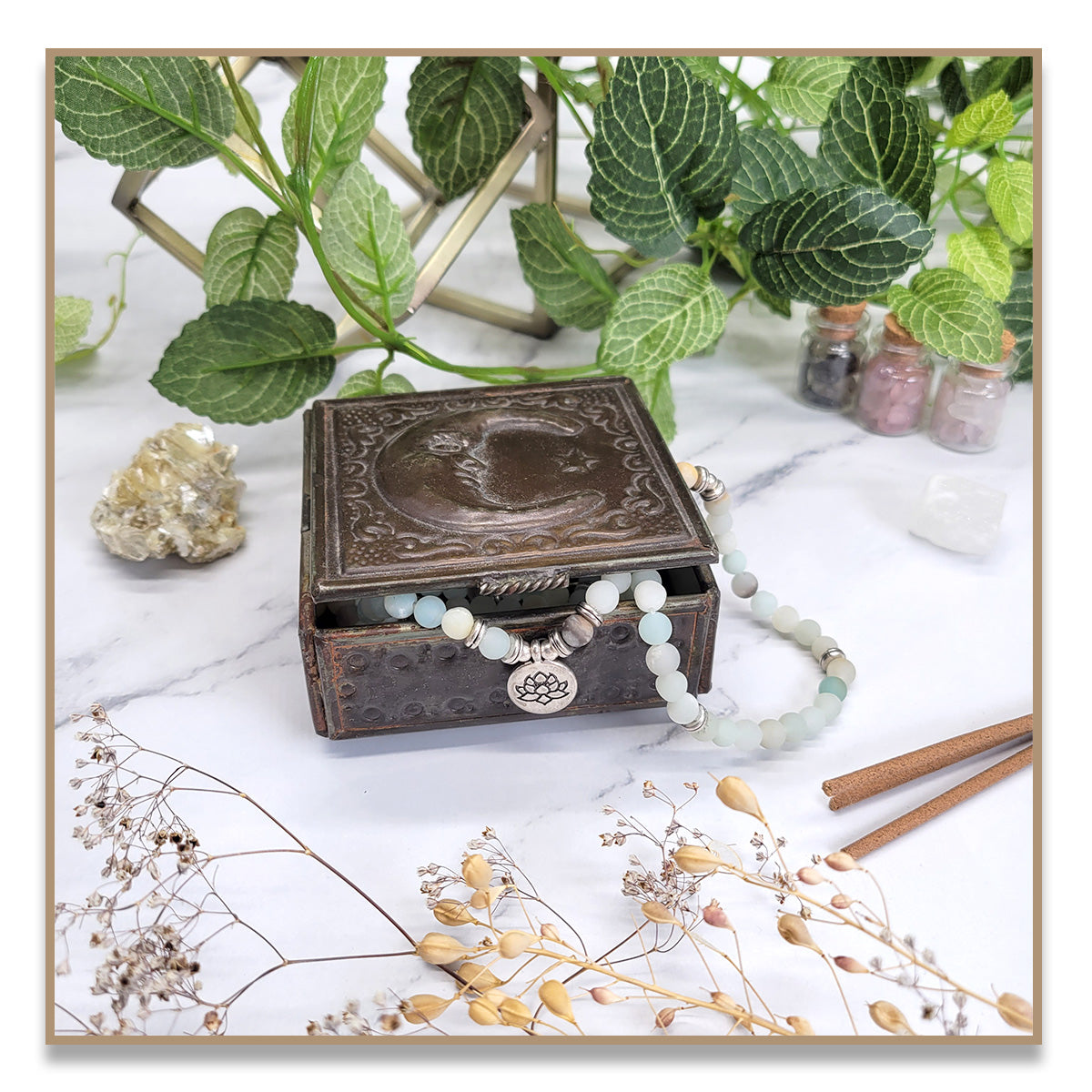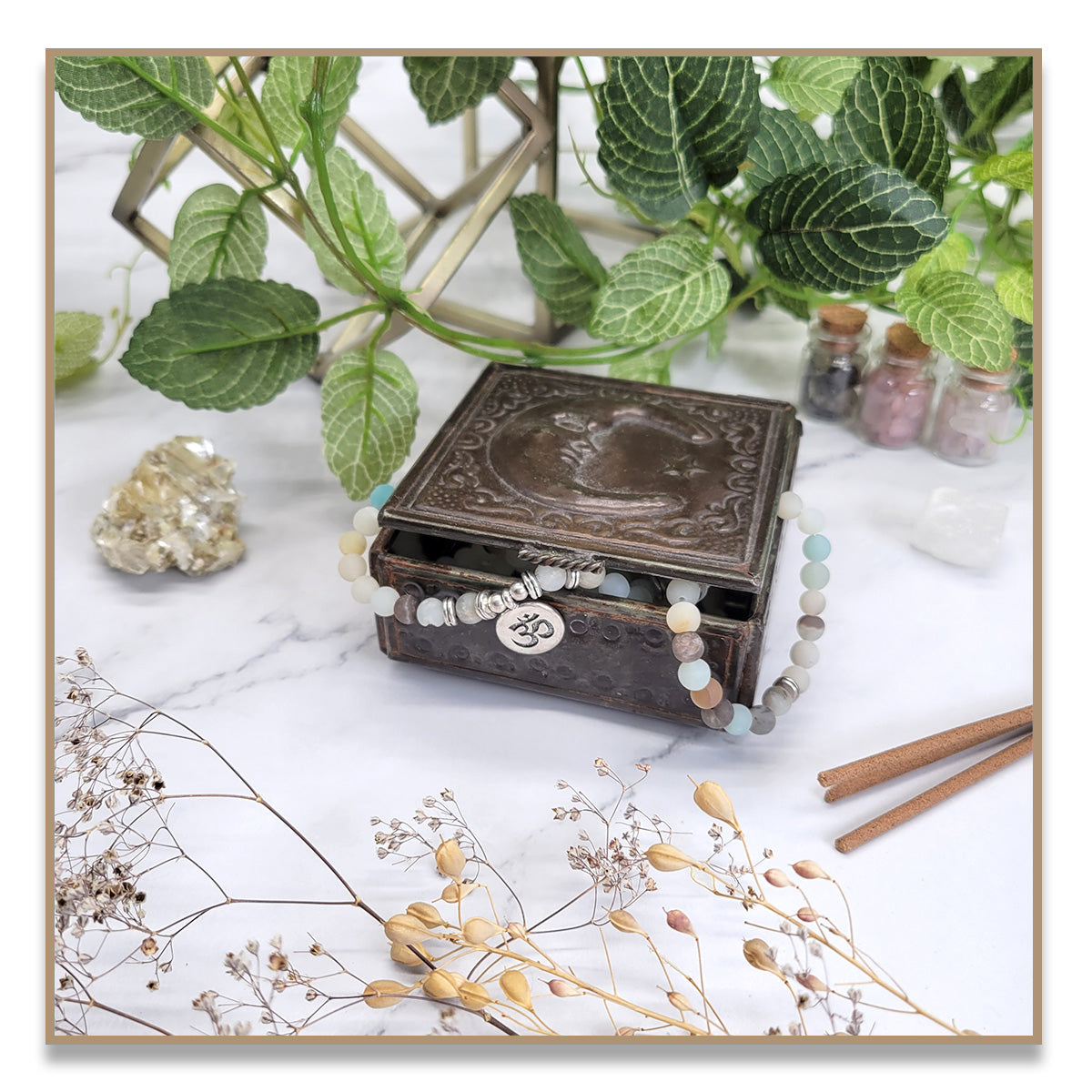Amazonite Mala (8mm)
Amazonite Mala (8mm)
Couldn't load pickup availability
A Mala is a loop of meditation beads to keep the mind focused and used to count mantras, prayers, or intentions. The word Mala means “garland” or “rosary” in Sanskrit. Mala beads are often referred to as mantra or meditation beads, Hindu rosaries, or Buddhist prayer beads.
You will receive ONE Amazonite Mala. See selection options above.
Our Malas have 108 beads. The guru / meru bead is either a Ohm or Lotus charm (See selection above).
Malas are long enough (~36 inches) to be worn around your neck or wrapped around your wrist. The main beads are Amazonite measuring ~8mm.
Learn more about Malas and the significance of the 108 beads below.
Why Does a Mala Have 108 Beads?
Why Does a Mala Have 108 Beads?
This is a question with hundreds of answers. The number 108 has seemingly limitless meanings across various philosophical, scientific, and religious beliefs. Some of the most interesting are:
• Sanskrit alphabet: There are 54 letters in the Sanskrit alphabet. Each has masculine and feminine, Shiva and Shakti. So, 54 multiplied by 2 is 108.
• Heart chakra: The chakras are the intersections of energy lines, and there are said to be a total of 108 energy lines converging to form the heart chakra. One of them, sushumna, leads to the crown chakra, and is believed to be the path to self-realization.
• Sun and Earth: The diameter of the sun is 108 times the diameter of the Earth. The distance from the sun to the Earth is 108 times the diameter of the sun.
• Moon and Earth: The average distance of the moon from the Earth is 108 times the diameter of the moon.
• Planets and houses: In astrology, there are 12 houses and nine planets. Twelve multiplied by nine equals 108.
• Powers of 1, 2, and 3: In math, 1 to the 1st power equals 1, and 2 to the 2nd power (or 2 x 2) equals 4, and 3 to the 3rd power (3 x 3 x 3) equals 27. Therefore, 1 x 4 x 27 = 108.
• Harshad number: 108 is a Harshad number, which is an integer divisible by the sum of its digits (Harshad is from Sanskrit and means "great joy").
• River Ganga: The sacred River Ganga spans a longitude of 12 degrees (79° to 91°), and a latitude of nine degrees (22° to 31°). Again, if you follow the math, 12 multiplied by nine equals 108.
• 1, 0, and 8: Some say that one stands for God or higher Truth, zero stands for emptiness or completeness in spiritual practice, and eight stands for infinity or eternity.
• Pranayama: If one is able to be so calm in meditation as to have only 108 breaths in a day, enlightenment will come.
• According to traditional Buddhism, 108 represents the number of mortal desires of mankind which one must overcome to achieve Nirvana.
What are malas made from?
What are malas made from?
"Malas can be made out of many different materials. The most common types of beads used in a mala are made from wood, seeds, or semi-precious gemstones. Depending on the material used, the properties of the beads will have certain energetic effects. Different spiritual practices and religious traditions historically have used beads of a specific material. In India, malas are primarily made from sandalwood, tulsi, and rudraksha seeds. In Nepal and Tibet, most malas are made from bodhi seeds, lotus seeds, and bone.
Sizes and types of beads
The counting beads in a mala are usually [...] 8mm [...]. Larger beads will be easier to count and practice japa with but will make the mala longer and heavier. Mala beads can be made from a single material or several different kinds of wood and stone beads. Mala beads may also contain thin metal spacer beads that are used for decoration and are not to be counted. The guru bead can be the same size as the counting beads or can be larger to stand out more. The guru bead is typically made from the same type of material as the counting beads."
Source: Japa Mala Beads
History of mala beads
History of mala beads
"Mala beads are used in other cultures and religions but are known by different names, such as prayer beads, rosary beads, and worry beads. Over two-thirds of the world’s population employ some type of counting beads as part of their spiritual practice. The use of beads in prayer appears to have originated around the 8th century B.C.E. in India.
Beads by themselves have had a powerful influence and importance in human history. The oldest beads found to date are approximately 42,000 years old. Beads have been used throughout our history as talismans for protection, amulets for luck, status symbols for wealth and authority, spiritual and religious tools, and as a form of barter. The meanings and use of beads have changed significantly over time—they have been used to symbolize personal and cultural relationships, physical, magical and supernatural power, and common cultural world-views".
Source: Japa Mala Beads
Benefits of mala beads
Benefits of mala beads
"Mala beads have been used in so many different spiritual traditions for so long because these beads have many powerful benefits for the body, mind and spirit. Some of the below eight benefits are universal for all types of prayer or counting beads but several of these benefits are specific to mala beads.
1. Increases focus during mantra meditation.
2. An efficient and practical tool to count mantras.
3. An easy way to keep track of the number of mantras recited.
4. Physical contact with prayer beads transmits their inherent healing powers.
5. Once mala is empowered it can be used for even more powerful healing of yourself and others.
6. Choosing a mala to purchase can help in process of determining goals and intentions and spiritual pursuits.
7. Seeing or wearing a mala can serve as a reminder of one’s intention and goals. It can also be used as a reward or symbol for accomplishing a difficult task."
Source: Japa Mala Beads
5 Things You Did Not Know About Malas
5 Things You Did Not Know About Malas
1. Malas are the oldest prayer bead.
Not only are malas like a rosary, they are the first rosary in recorded history. In fact, they arrived in the West after the Crusades encountered it in the East and adapted the mala into the Catholic rosary. The Muslim tasbih is also an adaptation of the original Hindu mala
2. They are an ancient calculator
Just like the abacus, for centuries, mala beads were used in South Asia to count and keep records for all manner of transactions and mathematical work.
3. The rudraksha mala is the most common
In previous times the gemstone mala was rare and infrequently used. Gemstone malas were historically reserved for the holiest men, and even then, the seed or wood mala was still most common. Only materials such as coral, clear crystal, pearls, and shell were used prior to the 18th century. Today gemstone malas are popular in the West but rarely used in the East. Only high lamas and the wealthy will use a gemstone mala in Tibet.
4. It does not need to be 108 beads
In fact Hindu and Buddhist malas will have different number counts depending on the sect. The first malas in documented archeological records have 50 beads, Shaivites use 32 or 64 beads, the Vishnavite mala has 108 beads, the Tibetan mala can have 111 beads. The extra number above 100 is to ensure a full 100 count, but the remainder is there to account for the wandering nature of the mind.
5. The tassel is symbolic of a lotus petal
Not just a form of adornment, the tassel marks the beginning and end of the sacred mala count. The lotus represents the human experience, signifying that even in muddy waters beautiful flowers emerge.
Source: Salt Spring Malas
** Please understand the above description is not a promise to cure ailments. Though I am a certified Usui Reiki Master, I am not a medical professional. The description is based on my experience, favorite crystal books, and online resources. **
Share
